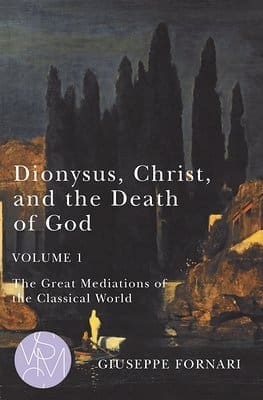W
Where is the best place to experience the spirit of what we call America? Is it the Jamestown church where the first colonial democratic assembly was held in 1619, or the Sixteenth Street Baptist Church in Birmingham? Is it Washington’s Capitol Hill or Richmond’s Shockoe Hill African Burial Ground? Mount Rushmore or the Crazy Horse Memorial? Plymouth Rock or Little Rock High School? Pearl Harbor or the Manzanar War Relocation Center? The Yorktown battlefield or Tippecanoe? Is the American spirit best understood on Monticello’s front lawn or in its now reconstructed slave cabins? In Princeton’s Nassau Hall or by the trees where the institution’s early presidents auctioned off their slaves? In Lincoln’s home or Douglass’s? At Gettysburg or Greasy Grass? Seneca Falls or Sand Creek?
Of course, choosing between these sets of options is to risk telling only one side of the American story, which the most vocal are happy to do. These opposing extremes deserve each other. But I think there is one particular site where both dynamics—the sin (which should be evident enough) and the splendour (the ever-expanding constitutional “We”)—can each be intensely felt, where one can literally sit between these poles and feel the tension between America’s oppressive and liberating aspects. I refer to the parlour of former president James Madison, primary architect and defender of the aforementioned “We.” For there in Madison’s drawing room in Virginia’s Montpelier, the tug-of-war between his classical sympathies are in perfect tension with his Christian ones. On one side of the room is a large baroque painting of Christ confecting the Eucharist, and on the other side is the retinue of the god Pan and the nymphs, part of the entourage of the Greek god Dionysus. The room might have something to offer pressing questions about American “masculinity” as well, both its nefarious dimensions (obvious to most) and the possibility (unimaginable for many) of masculinity transfigured.

Pan, Youths, and Nymphs, attributed to a seventeenth-century Dutch Caravaggist named Gerrit van Honthorst, is authentic—that is to say, it was in place when Madison was alive. In the painting, Pan surprises a group of revelers, one of them a young maiden with her chest exposed. The atmosphere is jovial. The presence of majestic Dionysus is evoked by the darkened distance behind Pan. It is difficult to determine whether the other painting was hanging when Madison was alive, but even so, the larger, towering canvas of Christ is impossible to ignore today. The disciples surrounding their longsuffering Lord seem to jockey for position as Christ looks, with exasperation, to his Father above.
Madison was famously reticent about his religious convictions, and perhaps we can therefore read in these two paintings the war in himself, and in the country that he helped found. In Madison’s spacious formal garden, where Dionysian themes are carved into decorative pillars, one senses that the contest for Madison’s heart was considerable. If the story of American architecture is in large part a contest between the classical style, representing secular ideals, and the Gothic, representing religious ones, then it is a story also played out in this central room of Madison’s home.
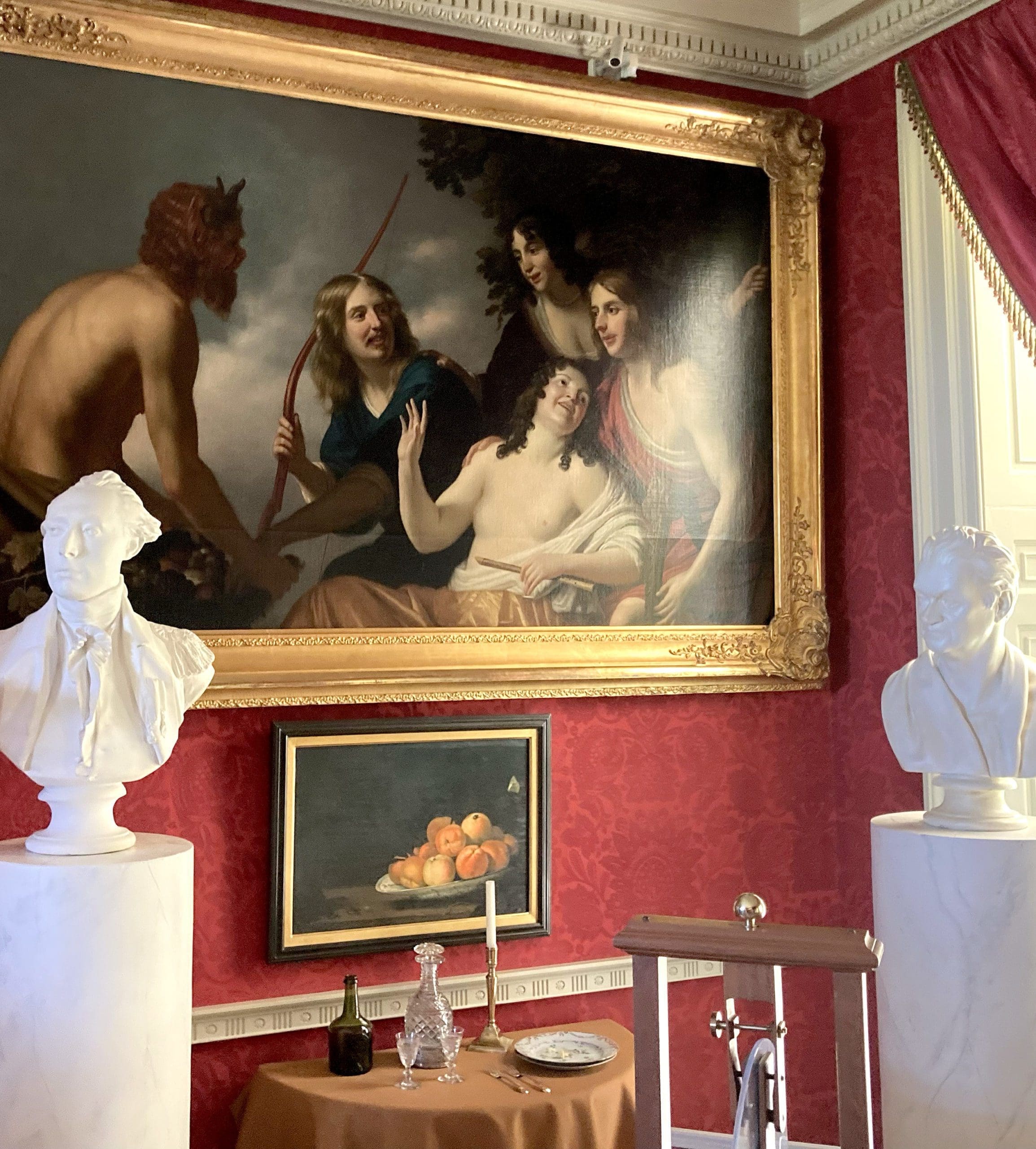
Pan, Youths, and Nymphs by Gerrit van Honthorst, ca. 1630. James Madison’s Montpelier. Photo by Matthew Milliner.
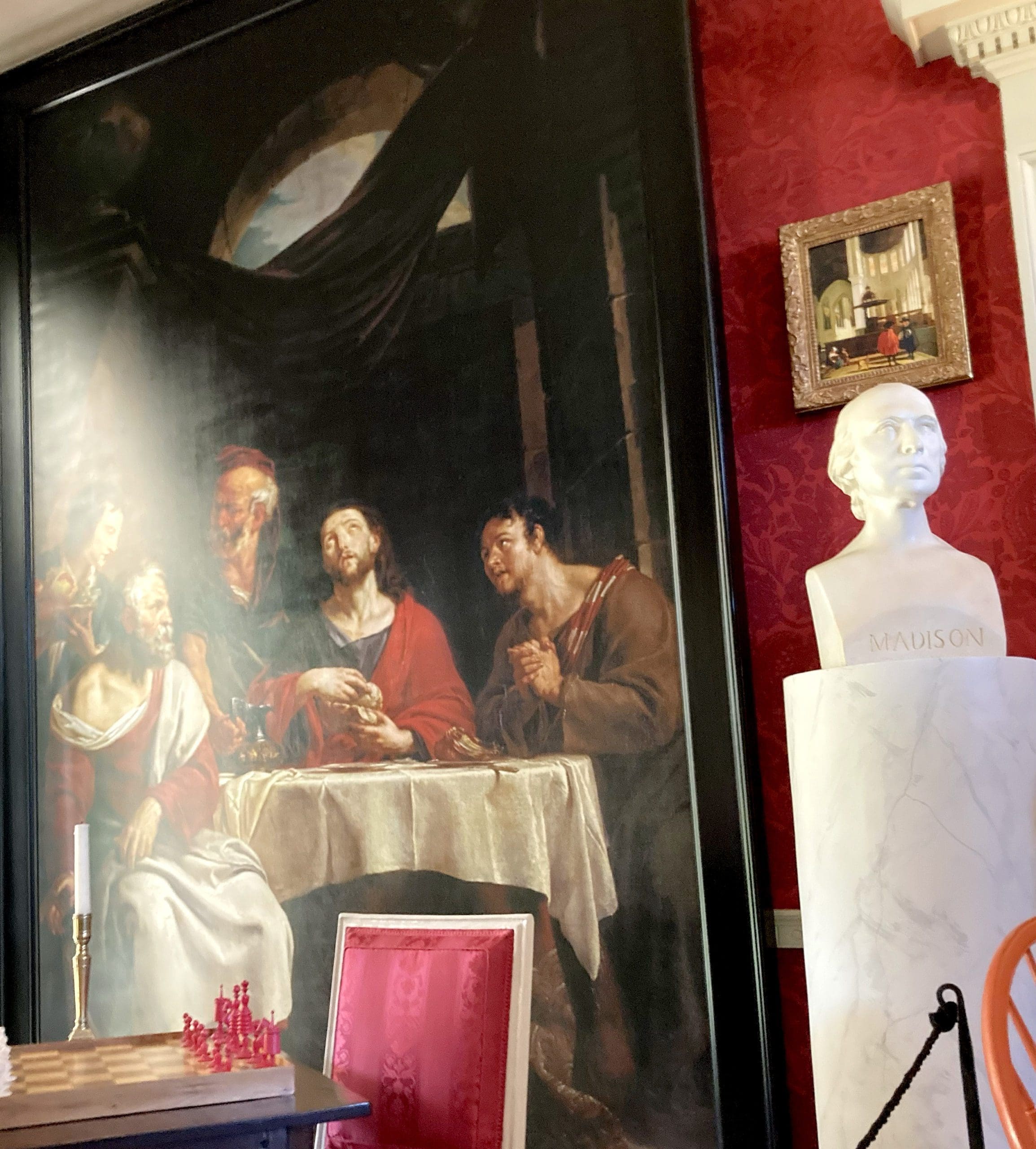
Supper at Emmaus by Peter Paul Rubens, 1610. Photo by Matthew Milliner.
An initial reading of this juxtaposition of paintings might stop short of seeing here a contrast between America’s repressive and emancipating aspects, seeing instead tensions inherent in Christianity itself. Perhaps we can see in Madison’s parlour painting of Pan the innocent festivities that Dolly Madison enjoyed as she departed from her strict Quaker origins, or that James Madison must have experienced as he cooled off from the fervent evangelicalism of his youth.
There is some truth to this view. More than a few traditional Christian thinkers have rightly inveighed against Christianity’s unhealthy animus to marital sex and vinicultural pleasures. Notable among them is the biodynamic farmer and Christian philosopher Michael Martin, who this year completed his splendid trilogy that unfurls the dynamics of Christian wisdom (a.k.a. “Sophiology”) with the publication of Sophia in Exile. The title is a play on the Gnostic creation myth of Sophia’s fall, a myth that Martin creatively reengineers against Gnosticism and in defence of the goodness of the physical earth. Which is to say, instead of worrying about Gnosticism, Martin launders it, paying to Gnosticism the same compliment that Aquinas paid to Aristotle.
But in the process, Martin shows just how much Christian faith in the presumed goodness of the created order has wavered over the centuries. Allegorical readings of the Song of Songs are legitimate for Martin, but only after we see the love song for what it is—“a Judeo-Christian Kama Sutra: not that it offers a variety of techniques for achieving sexual union and pleasure, but that it presents us with the archetype of the sacred marriage in all of its delights and its delicacies, its anxieties and its intimacies.”
Christianity, for Martin, has been unfaithful to this vision of faithful sex. “Christian culture, engineered by celibates and monastics . . . through compromised anthropology long ago disfigured the nuptial image into one that privileged their own social contexts and power.” What makes Martin’s argument of interest is that it is not lobbed from without but emerges from deep within the Christian tradition itself. Christian animus against eros, he argues, is an “ideological invasive species” that profoundly distorted the faith. “The Protestant Reform tried to correct this, but the disorder is in the grain.” Contemporary debates about “marriage” therefore are not even really about Christian marriage. The concept has been secularized, cut off from the hieros gamos (sacred marriage) of male-female union. “John Paul II’s Theology of the Body certainly tried to remedy this situation, but it was, really, too little, too late—two thousand years too late.”
As a corrective, Martin advises Christians, while remaining Christians, to make friends with Pan. He learns this from the writer Eleanor “Nellie” Farjeon (1881–1965). “For since the divine Pagan dares to exist in harmony with the eternal spirit,” this poet announces, “trees, which are the temples of Pan, are also prophets of God.” Such insights did not hinder Farjeon’s ultimate embrace of Christianity but seemed to make it almost inevitable. Martin in turn describes his lifelong fascination with Dionysus, who was the god not only of wine but also of honey. As Martin collects honey from his bees on his Michigan farmstead for fermenting mead, he feels deeply connected to Dionysus, who for Martin almost seems to be Christ in disguise. I imagine if Martin were to stand in Madison’s Montpelier parlour, he would see there a necessary middle ground between teetotalling Baptists and an outright bacchanal, territory that the evangelical Calvinists Madison knew so well had failed to confidently secure. Martin sadly cites Eamon Duffy’s The Stripping of the Altars: “Iconoclasm was the central sacrament of the reform.” The wine of Dionysus, for Martin and many other thinkers, might cure an ailment—a festering fear of physicality—that has too long afflicted Christian faith (1 Timothy 5:23).
Even so, another book published this year (two in fact), by the Italian scholar Giuseppe Fornari, moves in what appears to be a completely different direction. In Dionysus, Christ, and the Death of God, Fornari argues that any benign, romantic interpretation of the god Dionysus is nonsense. Violence was not exceptional to the Greek god of wine but constituent. To prove this assertion, Fornari draws on the history of philosophy, archaeology, biblical studies, anthropology, and theology from Mesopotamia to modernity. Fornari’s two volumes, the achievement of a lifetime, are richly informed by René Girard (1923–2015). Fornari applies and updates the great French anthropologist’s theory—Christianity’s exposure of sacralized violence—with systemic and creative precision. Which is to say, if Girard commendably cited Fornari in his classic I See Satan Fall Like Lightning, Fornari returns the favour here in spades.
In essence, Fornari shows that Thomas Mann’s revelatory moment in The Magic Mountain, in which the cult of Dionysus is premised on child dismemberment, is perfectly correct. He gives us all the data we need to confirm Mann’s intuition of the cult’s “terrible bloody center.” Fornari considers scholars who would hesitate to make these connections to be infected with a “customary ideological distrust of Christian sources.” Among Fornari’s most revealing discoveries is that the Eleusinian secrets, spoken of with great reverence today by those who promote psychedelics, are really not secrets at all. We should take the early Christian thinker Clement of Alexandria, probably himself a disillusioned Eleusinian initiate, at his word. Eleusis was really the cult of Dionysus in disguise, and this cult always entailed sacrifice, even if that sacrifice at a later date became more symbolic.
Fornari relies in particular on Origen to make his case for the ancient Christian sea change in morality. In his debates with the pagan Celsus, Origen—while conceding opportunistic conversions among some Christians—isolates a hitherto untapped spring of universal mercy that irrigated a parched world. Celsus, Fornari shows, was incapable of thinking past the possibility of vindictive deities. In Fornari’s work, the Christian revolution becomes, just as in Tom Holland’s Dominion, a documentary fact, one that most people take for granted today, even when they claim to be opposed to Christianity.
This brings Fornari to grapple with modernity. In an earlier and shorter translated volume, A God Torn to Pieces, English readers were already offered a teaser of Fornari’s grand thesis in this respect. Therein Fornari upends the many books that present Nietzsche as some kind of friendly intra-Christian critic. Nietzsche was not attacking Manichaean corruptions of Christian faith (as does Michael Martin). Fornari inveighs that Nietzsche was indeed attacking Christ himself, and in so doing Nietzsche got his wish: he became the god Dionysus—and, like the god Dionysus, Nietzsche was accordingly dismembered (that is, delivered to the psychic fragmentation of madness). But seeing Fornari’s insights nestled in a longer, two-volume history is much more satisfying and makes his insights more convincing. “It does no great service to the prophet of Dionysus to deny him the tragedy that is his, and is his authentic legacy, in which the entire Western world has been reflected without recognizing it.” Indeed, “nobody offers a more tragic and eloquent testimony to the significance and inevitability of Christ’s cross than Nietzsche, who comes to identify with it totally.”

The interior of the Oude Kerk, Amsterdam, with elegant figures conversing by a follower of Emanuel de Witte, 17th century. James Madison’s Montpelier. Photo by Matthew Milliner.
Rather than criticize Christian approaches to sexuality, Fornari believes we should celebrate the elimination of the hieros gamos, which was sexuality’s deification. If Jews and Christians are less enthusiastic about sex than many today would like them to be, this is because they are resisting its ritualized intensity and its pairing with violence in the classical world. Fornari offers a moving meditation on the Virgin Mary’s fulfillment of pagan myth: “The many Pasiphaes forced to give birth to their Minotaurs find their redemption in Mary, as do the countless women condemned to be prostitutes and sacrificial victims.” Fornari can say this “not because [Mary] is herself [the] center but because she takes us to it.” Indeed, to return to Madison’s living room, just to the right of the portrait of Christ, another Dutch painting offers a classic depiction of the interior of a church with a woman modestly nursing her child on the ground (a Reformed proxy for Mary). It almost seems to be an answer to the bare-chested girl, exposed and vulnerable, in the Pan painting, and is a fitting illustration of Fornari’s point.
It is not difficult to speculate what Fornari would make of Madison’s parlour contrast between Dionysus and Christ. Only one of these paintings, Fornari would surely argue, represents the kind of America that most Americans hope for, whether Christian or not. Only the Christ painting evokes self-sacrifice, regard for the downtrodden, love for one’s enemies. The other, jolly as its surface may appear, symbolizes an America with the lesser trodden underfoot. Fornari’s proof for this, no doubt, would be slavery. Madison hated the institution of slavery, but the execution of a slave was, to speak in Girardian terms, the founding murder of his estate. Madison never freed his slaves; his debts, like Thomas Jefferson’s, precluded the realization of this ideal. And what better justification for this arrangement is there than Dionysus?
More than a few ancient mosaics show the wine god’s entourage whipping the dark-skinned foreigners that Dionysus conquered. In one such mosaic on the island of Cyprus, Pan is even given the whip himself. Christianity surely had its own justifications for slavery, but ultimately such doomed vessels would be wrecked on the sharp shoals of the New Testament itself. There was no such mitigating mercy, however, in the rites of Bacchus (Dionysus’s Roman name).
As it happens, however, we need not choose between Michael Martin’s pro-Dionysian Christian vision and Giuseppe Fornari’s justified attack on the god. The Christian tradition is wide enough for both. Some modern advocates of Bacchus, insofar as they instinctually resist sacrificial violence, unknowingly smuggle Christian contents into their arguments; but Michael Martin is different. He is too sophisticated a thinker to be unaware of the extent to which his benevolent view of Dionysus is possible only because of the Christian revolution. Moreover, as if ceding ground to Martin, Fornari argues that it was very much the case that the best of the wine god was redeemed in “propitious contaminations” of the Judaic and Christian traditions. Even the Eucharist depicted in Madison’s painting of Christ is, for Fornari, “the mystic union of Demeter’s cereals with the wine of Dionysus.”
The best of the wine god was redeemed in “propitious contaminations” of the Judaic and Christian traditions.
Let me offer a few of my own illustrations to the Dionysus debate. Visitors to the Metropolitan Museum of Art will be familiar with the Antioch chalice, where Christ, joyfully tangled in vines, inherits all the wine-bibbing delight of his predecessor. The claim that this mysterious vessel is the actual Holy Grail “has not been sustained,” according to the Met, but—as Michael Martin reminds us—anything can be the Grail. Others will be aware of a nude statuette of Dionysus at the State Hermitage Museum in St. Petersburg with the text of a psalm (“Do not drag me away with the wicked” [Psalm 28:3]) reverently inscribed by Byzantine Christians across his belt. It illustrates male sexuality appropriately siphoned, but not snuffed. Likewise, near the violent Dionysus mosaics on Cyprus referenced above is the mosaic of a wine vessel enhancing the floor of an ancient Christian church that pleads, “I [Christ] am the true vine” (John 15:1). It took me hours to find that mosaic one sweltering summer, just as it will take most men considerable time to find themselves at home in their God-given gender. But find the mosaic I did.
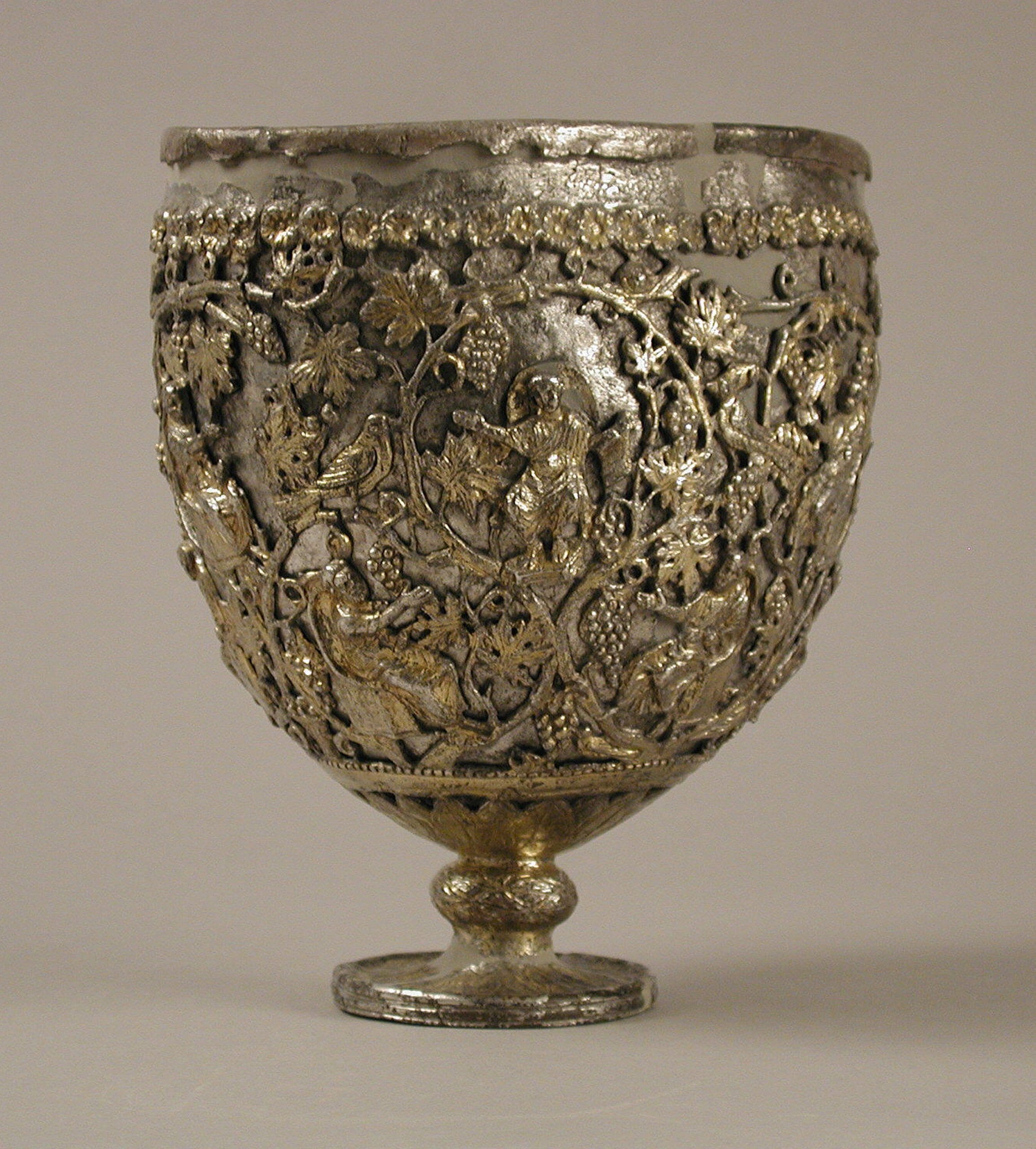
The Antioch “Chalice”; Metropolitan Museum, New York.
And this is not even to mention the great tradition of the propitiously named Dionysius the Areopagite (ca. 500), the Christian Platonist with a kinder, less severe approach to the body than standard ascetic approaches, even to the point of offering an early theology of the body himself: “The many parts of the human body can provide us with images which are quite appropriate to the powers of heaven.” The late-antique poet Nonnus, moreover, happily composed both Dionysian epics and Christian ones. But such qualified Christian embraces of Dionysus were crafted in a world where Gregory of Nyssa could make a metaphysically consistent attack on slavery. Closer to our own time, there is C.S. Lewis: “I wouldn’t have felt very safe with Bacchus and all his wild girls,” explains Susan in Prince Caspian, “if we’d met them without Aslan.” In short, the Christian order offers the love of wine and sex (within the bounds of chastity) and a passionate protest of slavery and the racism that still follows in its hideous train. But what happens when the lion is no longer present and we are left with the drunken Bacchus alone?
What happens when the lion is no longer present and we are left with the drunken Bacchus alone?
Reading the culmination of Martin’s trilogy alongside Fornari’s doubleheader is like taking a long weekend away from the turf struggles of jostling public opinion. One returns to the digital fracas refreshed, less offended than amused that Christianity is blamed for a presumably morbid focus on sacrifice when it was in fact sacrifice and violence that the religion effectively ended, enabling us to create fables of benign, “earth-loving” paganism that did not actually require blood. To minds moulded by news algorithms that feature the failures of Christian faith with calculated intensity, Fornari’s and Martin’s uplifting of the religion’s truth may seem nonsensical. But both authors, having examined the plate tectonics beneath our shifting cultural surface, forestall any such critique. For Fornari, “there has ever thrived a persecutory Christianity in perpetual contradiction with the gospel message.”
There are many servants of Dionysus, in other words, who claim the name Christian, and many self-professed pagans who, in their repudiation of violence, secretly serve the Lamb. Martin is equally unblinking when assessing the damaged state of Christianity, which “has been haunted by a Gnostic disdain for the flesh, as much as it has tried to overcome it.” And yet his trilogy is a gold mine of sources (a great number of them Protestant) that offer the corrective. In short, Martin very much believes we need to be saved from Christianity; but only Christianity is up to the task.
There are many servants of Dionysus, in other words, who claim the name Christian, and many self-professed pagans who, in their repudiation of violence, secretly serve the Lamb.
Still, the further we get from participation in, or even simple memory of, Christ’s final oblation, we seem to require fresh ones. With our present divisions in mind, Fornari writes, “Quite clearly Christianity . . . can only be on the side of the losers . . . on the side of those who make history by being forgotten, while the rampant globalitarianism in which we live triumphs across the board.” On this, Martin appears to be in agreement. Despite his embrace of the Christianized god of wine, he is stone-cold sober regarding the challenges that new technologies, irresistibly enhancing our phones and our factory farms, have presented.
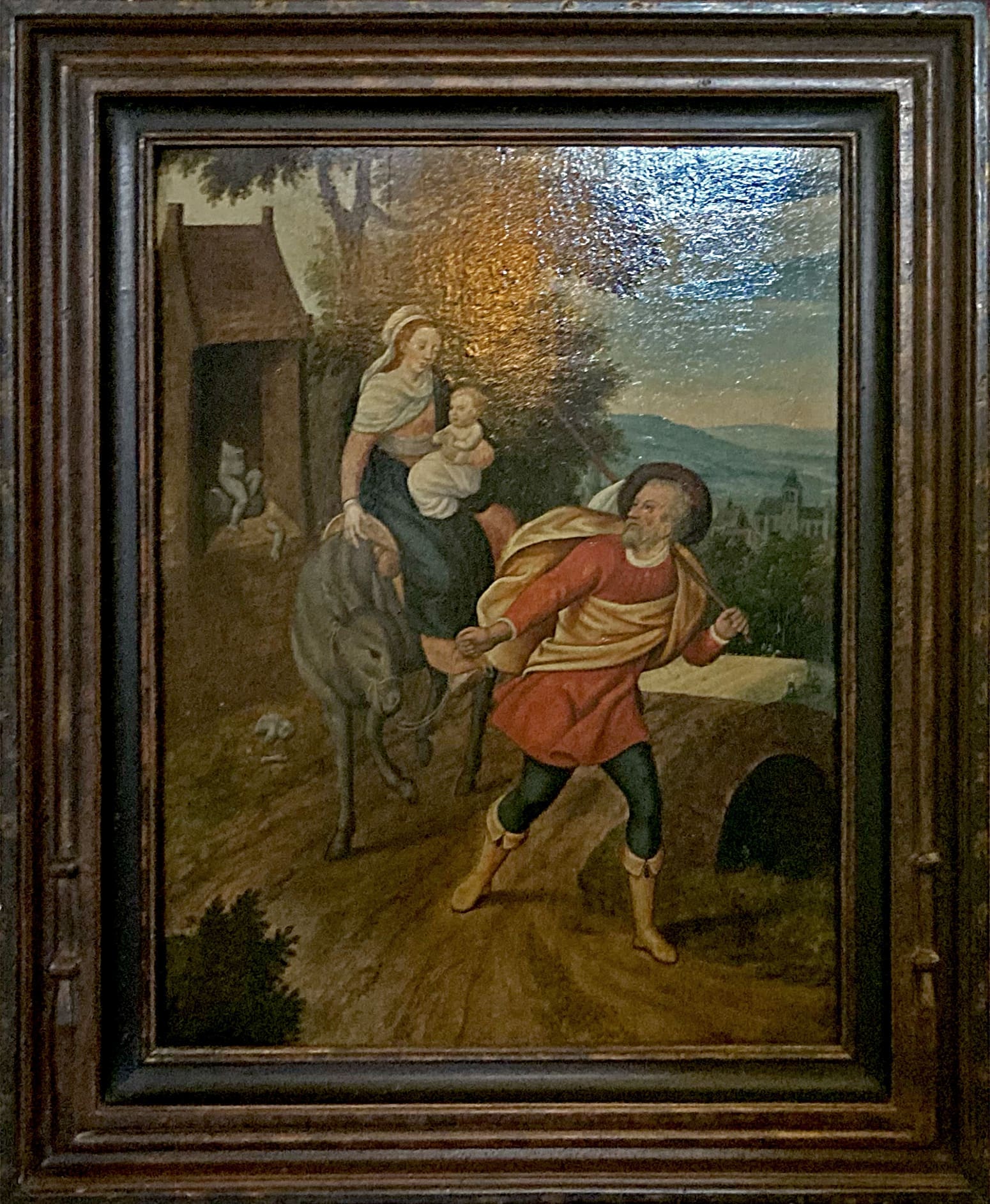
The Flight into Egypt by a follower of Maerten de Vos, 16th century. James Madison’s Montpelier. Photo by Matthew Milliner.
Even so, just as one leaves Madison’s home today, before one exits to enter the reconstructed slave quarters, there is another painting on display: the Holy Family escaping into Egypt. Bedecked in yellow and red, Joseph exhibits passions that are vibrant but controlled. Caretaker of the Christ child, he quietly represents what to some is an impossibility: Christian masculinity redeemed. In coming decades, many may look back with longing to the kind of masculinity represented by Joseph, a nostalgia triggered by unsavoury encounters with a post-Christian masculinity to come. Pagan machismo ensures an eternal return to America’s less-than-heroic pathologies with which this essay began. But in the meantime, there is still enough of the Christian order to savour.
Just behind Joseph, an idol—perhaps the child Dionysus—the same colour as the stubborn mule, is crumbing apart. And that is no matter. He was but a shadow of the child to come. We have received from Dionysus that which we needed. His grapes contributed to a vintage that no pagan mind had dreamed of: a single cup that slaves and masters, men and women, vagabonds and globalitarians would share.
Giuseppe Fornari, Dionysus, Christ, and the Death of God, vol. 1, The Great Mediations of the Classical World (East Lansing: Michigan State University Press, 2021)




